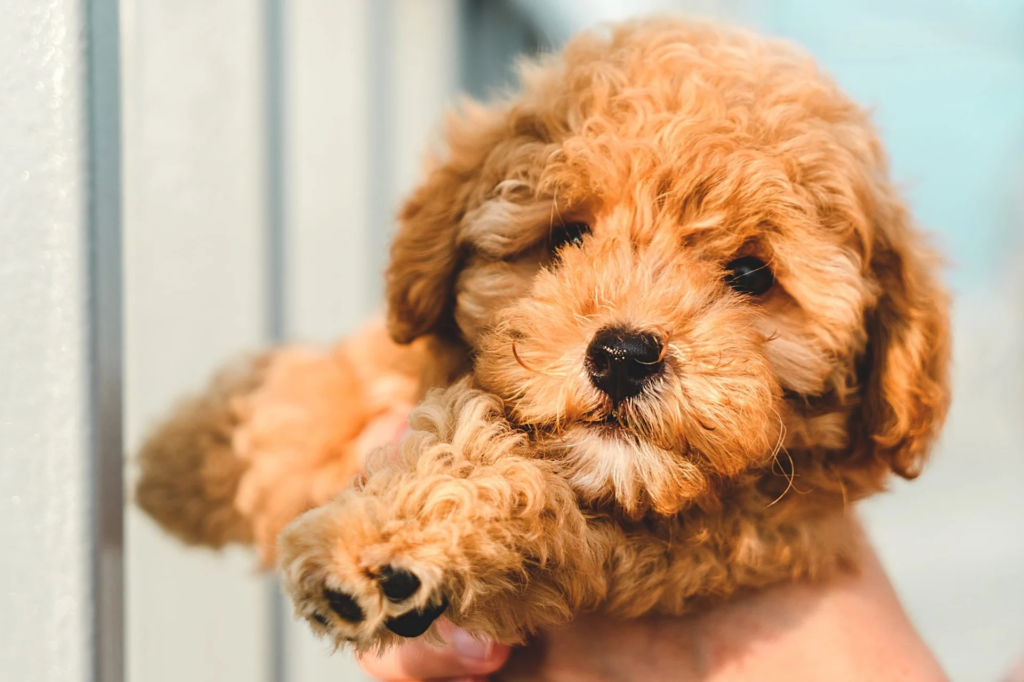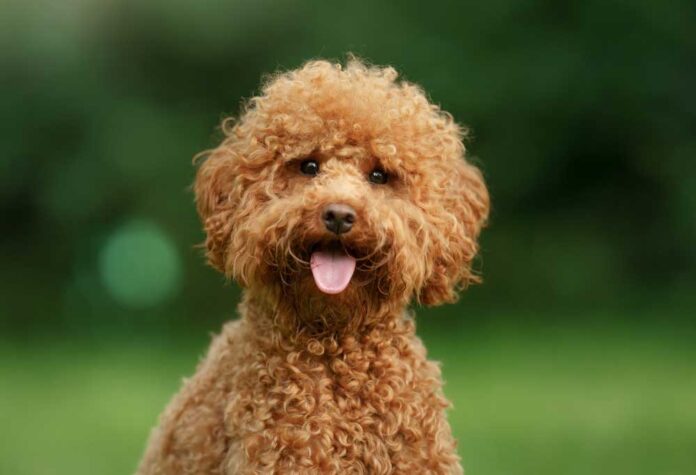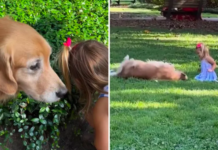Last Updated on August 31, 2023 by Fumipets
All You Need To Know About Miniature Poodle
The Miniature Poodle is a smaller version of the standard Poodle breed, known for its intelligence, elegance, and versatility. Despite its small size, the Miniature Poodle possesses the same characteristics as its larger counterpart, including a hypoallergenic coat, exceptional trainability, and a friendly disposition.
Originally bred as a water retriever, the Miniature Poodle has adapted well to various roles, from a loyal family companion to a skilled performer in dog sports and activities.
Miniature Poodle
Miniature Poodles are intelligent, active canines who enjoy company and are simple-going. Despite being regularly referred to as a picky breed, miniature poodles make excellent family dogs because of their intelligence, eagerness to-please attitude, and gentle nature among children and other animals.
They blend in nicely with most homes and families since they are a breed that is simple to teach, low-allergen, and low-odor. Despite the fact that their low-shedding curly coats are almost hypoallergenic, they still need a lot of maintenance and grooming. They form devoted and devoted friends if you have the time and money to devote to them.
The average price of a tiny poodle puppy is roughly $900, but a miniature poodle with an exceptional pedigree will likely cost more than double that amount.
Appearance
The American Kennel Club (AKC) recognizes the standard, miniature, and toy sizes of poodles. Standard poodles are the biggest and toy poodles are the smallest, placing miniatures in the center of the group. Although the AKC has not yet recognized the Klein or medium poodle and the miniature poodle, some breed aficionados contend that there are actually five poodle divisions.
Miniature poodles normally weigh between 10-15 pounds and stand between 10-15 inches tall. Due to their beginnings as water-retrieving dogs for duck hunters, miniature poodles share the same athletic, muscular physique as their standard and toy-size counterparts.
Mini poodles share the vivacious features, curly coats, and dark eyes of their breed brothers. Most tiny poodle owners prefer the understated sports clip, a short, one-length cut that appears a bit less like a topiary, to the complex continental haircut, which is popular with show poodles and has curling pom-poms neatly sculpted and trimmed around the joints and chest.
Adore dogs of a specific color in particular? No issue. There are several different colors available for the tiny poodle, including black, white, apricot, grey, silver, and brown. With a tiny poodle around, you won’t need to stock up on lint rollers because the breed tends to shed very little. Additionally, poodles of all sizes might be a suitable choice for allergy sufferers even though no dog is entirely hypoallergenic.
Temperament
The temperament of tiny poodles is also at the center of the pack when compared to other dogs of the same breed. The standard poodle is the calmest of the three, whereas little toy poodles are somewhat more energetic. All poodle breeds have a tendency to be shy and worried at times, and they thrive in quiet homes with lots of love and care.
Poodles of little sizes are witty, energetic, and lively. As pups and young dogs, they like running around and playing almost nonstop. Although their levels of activity do alter as they age, you should anticipate your tiny poodle to remain rather active even as an adult dog.
I’ve seen that tiny poodles are simply content and smart dogs during the past 45 years. They have an inherently happy and lively disposition.
Poodles who are good with people are simple to teach and enjoy making their human friends happy. Their responses to meeting new people might vary from pleasant and courteous to frightened and reserved. By socializing them early and giving them a secure, conflict-free living situation, you may assist your mini avoid hypersensitivity and anxiety, which can occasionally be caused by their sensitive nature.
The good news is that most tiny poodles come with wonderful temperaments by nature. That can truly represent a variety of factors, but socialization—whether it is practiced or not—is by far the most important one.

Living Needs
These little athletes like having room to run about and use up their excess energy, so regular excursions to the dog park or a large, fenced-in yard are advantages. Due to their little stature, they may successfully live in an apartment as long as their exercise requirements are satisfied.
They will require a lot of activity. There must be daily jogs or walks, games, and interaction.
Expect to spend a lot of one-on-one time with your dog since your tiny needs a lot of mental and physical stimulation through play, games, and training. Miniature poodles are calm canines who like playing nicely with kids. And poodles may get along with other animals if they receive the right socialization.
However, because they might be neurotic, poodles may not flourish in an environment with many guests or a busy, hectic lifestyle. Your tiny poodle won’t become unduly wary and shy thanks to early socialization. Minis like time spent with their owners because if they are left alone too much, they may get lonely or develop separation anxiety. Poodles need a lot of care and mental stimulation to keep them entertained. They won’t appreciate being left alone and bored.
Care
Because of their non-shedding coats, miniature poodles are frequently a perfect choice for allergy sufferers. However, just because a coat doesn’t shed doesn’t make it low-maintenance. Your tiny requires regular brushing, according to Bonk, to avoid matting. Miniature poodles need frequent grooming sessions or an owner who is extremely proficient with clippers, even when they only receive a simple one-length all-over sports cut.
Due to their high level of activity and athleticism, miniature poodles require frequent exercise and lengthy daily walks. It won’t be difficult to keep them occupied because they love to explore new things. Because they like it so much, miniature poodles may get great exercise from swimming. Minis also like chasing after balls and sticks in the garden while playing fetch to burn off some of their boundless energy. These small athletes also do well in agility and obedience drills.
Poodles enjoy jumping up on things and are extremely intelligent canines. As a result, I would suggest training them to jump up on anything raised in the beginning, such as a low chair, sofa, or bed.
Miniature poodles are extremely intelligent, relatively simple to train and enjoy making their owners happy. Avoid monotonous training and to make it positive and enjoyable. Your eager-to-please mini will be in his zone if you consistently give him heaps of praise. Because they enjoy being around humans, tiny poodles are often simple to housebreak.
Poodles as a breed don’t have any distinctive nutritional needs. Just make sure they have access to plenty of fresh, clean water and a nutritious diet of high-quality dog food. For your dog’s age and nutritional requirements, your veterinarian ought to be able to suggest a diet with the appropriate ingredients.

Health
In general, miniature poodles are healthy dogs who have long lives of 10 to 18 years. Reputable poodle breeders regularly test their canines for ailments that tiny poodles are prone to, such as hip dysplasia, eye disorders, and orthopedic problems like luxating patella. Additionally susceptible to Legg-Calve-Perthes and Von Willebrand’s disease are miniature poodles.
Dental problems are very common in miniature poodles. Regular dental cleanings, whether done at home or by your veterinarian, are essential since tartar buildup can result in more serious problems including infection, tooth loss, and organ damage. It would be easier for you to be informed about the health and well-being of your specific tiny poodle if you keep the regularly scheduled veterinarian checkups.
History
According to the AKC, poodles were first used as duck hunters in Germany. The term “poodle” is derived from the German word “pudelin,” which alludes to the breed’s love of the water. These animals make the best employees for water recovery due to their intelligence, swimming prowess, and protective coat. Although standard poodles used to be the most popular breed size for hunting, many sports organizations now utilize their smaller relatives to help flush out game from bush.
The complex continental clip that most people identify with the poodle has a purpose beyond simple fashion. Originally, the unusual cut was designed to keep dogs employed for water retrieving buoyant and comfortable in frigid waters. According to the AKC, this allowed the dogs to move freely while swimming while safeguarding their internal organs and joints by leaving the hair longer in those regions.
The aristocracy of France gradually grew attracted to its amiable nature and endearing appearance, and the species quickly gained popularity across Europe. Due to their trainability and inherent grace, poodles of all sizes were the stars of several European circus shows. The standard poodle is said to have been the original breed, with the miniature and toy variants emerging later.
Q&A about the Miniature Poodle:
1. What is the history of the Miniature Poodle?
The Miniature Poodle shares its origins with the Standard Poodle, which was bred in Germany as a water retriever. Over time, smaller versions were developed to serve as companions and performers.
2. How does the coat of a Miniature Poodle differ from other Poodle sizes?
The coat of a Miniature Poodle is the same as the standard Poodle’s: curly, dense, and hypoallergenic. Regular grooming is necessary to prevent matting and to maintain the coat’s health and appearance.
3. What is the temperament of the Miniature Poodle?
Miniature Poodles are known for their intelligence, lively nature, and friendly demeanor. They tend to form strong bonds with their families and are often eager to learn and engage in various activities.
4. Are Miniature Poodles good for families with children?
Yes, Miniature Poodles can make wonderful family companions. They are generally patient with children and their smaller size can be more suitable for households with limited space.
5. How much exercise do Miniature Poodles need?
Despite their smaller stature, Miniature Poodles are energetic dogs that require regular exercise to stay healthy and happy. Daily walks, playtime, and mental stimulation activities are important for their well-being.
https://www.youtube.com/watch?v=pq9J2SHyeKw


















